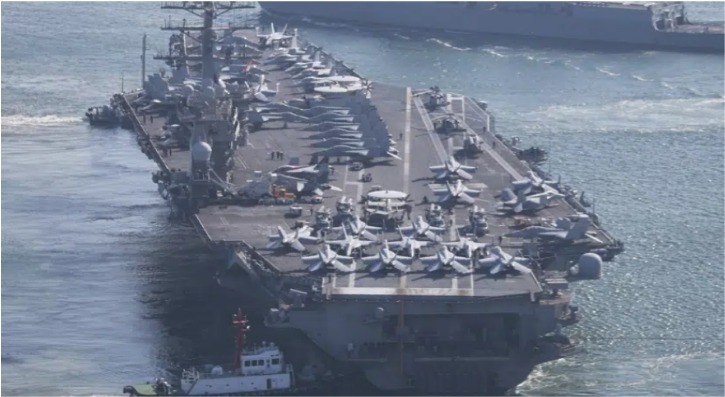
The US, South Korean, and Japanese navies have launched their first joint anti-submarine exercises in six months. The drills come amid growing concerns over North Korea’s increasing missile threats, particularly after the country recently unveiled a type of battlefield nuclear warhead.
The two-day exercises are being held in international waters off South Korea’s southern island of Jeju. The drills involve the nuclear-powered USS Nimitz aircraft carrier and naval destroyers from all three countries. The main objective of the exercises is to improve their ability to deal with security threats from North Korea’s advancing submarine-launched ballistic missiles and other assets.
The drills involve the detection and tracking of unmanned South Korean and US underwater vehicles posing as enemy submarines and other assets. North Korea’s development of submarine-launched missiles is of serious concern to the US and its allies because such launches are harder to detect in advance.
North Korea performed a number of missile tests in March, including a nuclear-capable underwater drone and a submarine-launched cruise missile. These tests indicate that the country is trying to diversify its underwater weapons systems.
Photographs released by North Korea last week showed leader Kim Jong Un standing near approximately ten red-tipped warheads called “Hwasan (volcano)-31” with different serial numbers. The warheads can be carried by eight kinds of short-range weapons that have been tested previously and are capable of hitting key targets in South Korea, including US military bases there.
Some analysts suggest that the unveiling of the warhead may be a prelude to a nuclear test, with previous tests in 2016 and 2017 having followed the disclosures of other warheads.
Foreign experts continue to debate whether North Korea has functioning nuclear-armed missiles, but South Korean defense minister Lee Jong-Sup has informed lawmakers that the country’s technology to build miniaturized warheads to be mounted on advanced short-range missiles has made considerable progress.
Although North Korea could launch new missile tests in protest at the South Korea-US-Japan drills, the three countries plan to practice humanitarian search-and-rescue operations, including saving people who fall into the water and treating emergency patients. The exercises will mark the first time such training has taken place in seven years.
The joint exercises come after North Korea recently unveiled a type of battlefield nuclear warhead, raising concerns the country may perform its first nuclear test since 2017. The US and its allies are closely monitoring the situation and have called on North Korea to abandon its nuclear and missile programs.
The US has long been concerned about North Korea’s missile capabilities, particularly its ability to launch nuclear-armed missiles. In 2017, North Korea successfully tested an intercontinental ballistic missile (ICBM) that experts say could reach the US mainland.
Since then, the US has been working with its allies to try to reduce the threat posed by North Korea’s missile program. The joint exercises are part of these efforts and are aimed at improving the ability of the US and its allies to detect and respond to North Korean missile launches.
In addition to the joint exercises, the US has also been working to impose sanctions on North Korea in order to pressure the country to abandon its nuclear and missile programs. The US has also been working to build a missile defense system that could protect the US and its allies from North Korean missile attacks.
Despite these efforts, North Korea has continued to develop its missile program. In addition to its submarine-launched missiles, North Korea has also developed other types of missiles, including ICBMs that could reach the US mainland.
The US and its allies are closely monitoring the situation and have vowed to take whatever steps are necessary to protect their citizens from the threat posed by North Korea’s missile program
